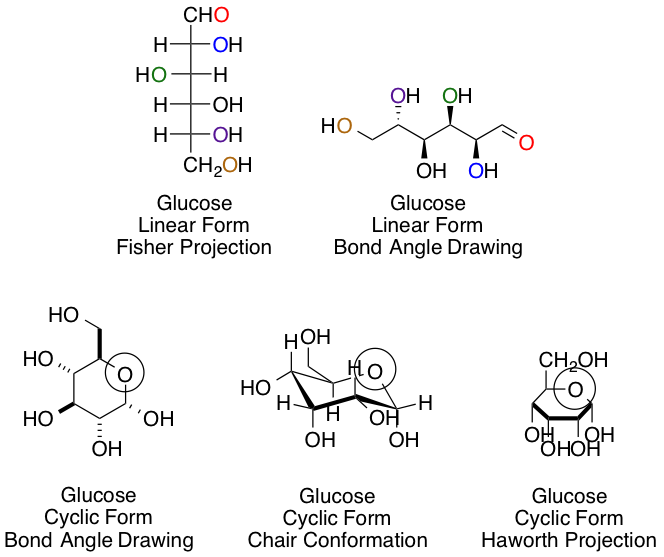Help with Organic Carbohydrates
Help Questions
Organic Chemistry › Help with Organic Carbohydrates
What is the name of the following carbohydrate?

Alpha-D-galactopyranose
Alpha-L-galactopyranose
Beta-D-galactofuranose
Alpha-L-glucopyranose
Beta-D-galactofuranose
Explanation
Stereochemistry from second to fifth carbon is R, S, S, R, which indicates D-galactose. The Haworth structure is a six-membered ring, so the molecule is in its pyranose form. The molecule has its anomeric hydroxyl group pointing down, so it's the alpha anomer.
What is the name of the following molecule?

Alpha-D-glucofuranose
Beta-L-glucofuranose
Alpha-D-glucopyranose
Alpha-L-galactopyranose
Beta-D-galactofuranose
Explanation
Stereochemistry from second to fifth carbon is R, S, R, R, which indicates D-glucose. The Haworth structure is a five-membered ring, so the molecule is in its furanose form. The molecule has its anomeric hydroxyl group pointing down, so it's the alpha anomer.
Chemists and biochemists have many ways of representing sugars. Glucose, the most common hexose, is shown below in various linear and cyclic projections. Using the linear and cyclic projection of your choice, can you indicate which colored oxygen in the linear form corresponds to the circled hemiacetal oxygen once the cyclization reaction is complete?

Purple
Red
Blue
Green
Yellow
Explanation
This answer, regardless of your preference of projection type, is easiest to obtain using arrow pushing for the cyclization reaction to keep track of each carbon and oxygen:

The purple carbon in the linear projection ends in the circled hemiacetal position.
Which of the following correctly describes a reducing sugar?
A reducing sugar has a hemiacetal/hemiketal group when in its cyclic form, and is able to reduce other chemicals (while itself being oxidized).
A reducing sugar has an acetal/ketal group when in its cyclic form, and is able to reduce other chemicals (while itself being oxidized).
A reducing sugar has a hemiacetal/hemiketal group when in its cyclic form, and is able to oxidize other chemicals (while itself being reduced).
A reducing sugar has an acetal/ketal group when in its cyclic form, and is able to oxidize other chemicals (while itself being reduced).
None of these
Explanation
A reducing sugar contains a hemiacetal/hemiketal group which means that in its open chain form it contains a ketone/aldehyde group. Sugars containing a free aldehyde group can be oxidized to a carboxylic acid, while sugars containing a free ketone group must be tautomerized to an aldehyde group through an ene-diol intermediate (shown below), and this can be oxidized to a carboxylic acid.

Reducing sugars are detectable with the formation of either a precipitate or a solution color change after addition of Tollens' Reagent, Benedict's solution, or Fehling's solution.
Which of the following statements is true regarding carbohydrates?
All of these
In nature, carbohydrates are usually found with a "D" conformation
Aldoses are more common in nature than ketoses
The anomeric carbon is the site of attachment from one monosaccharide to another
Explanation
All of these statements are true. A carbohydrate is said to have a "D" conformation in its acyclic form when the alcohol group on the carbohydrate's top stereocenter is on the right side in a Fischer projection. Most carbohydrates that we deal with in organic chemistry are aldoses, which means that they contain an aldehyde. The anomeric carbon is the site of attachment from one monosaccharide to another, and can be used to create polysaccharides.
Shown below is the structure of a sugar molecule.

Which of the following is the most appropriate classification of this sugar?
Aldoheptose
Aldohexose
Ketoheptose
Ketohexose
Explanation
In this question, we're given the structure of a sugar molecule, and we're asked to identify which answer choice represents the correct identification of this molecule.
To answer this question, there are two things we need to look at. For one, we need to determine whether it is an aldehyde sugar (aldose) or a ketone sugar (ketose). The first carbon atom in the molecule (shown at the very top in the image) is shown as 
Next, we need to look at the number of carbon atoms in the molecule. In the image shown in the question, there are a total of seven carbon atoms. Thus, this sugar would be classified as a heptose sugar (seven carbons) rather than a hexose sugar (six carbons).
Putting these two pieces of information together, we know that the sugar is both an aldose and a heptose. Therefore, this sugar is an aldoheptose.
Alpha-D-glucopyranose

Which of the labelled carbon atoms is the anomeric carbon?
A
B
C
D
E
Explanation
The anomeric carbon is formed from the original carbonyl carbon in the straight-chain form of the molecule being attacked by a hydroxyl group to form a hemiacetal. This is seen as a carbon that is bonded to two oxygen atoms. In the case of glucose, the carbon labelled A is a hemiacetal, and is considered to be the anomeric carbon.
Alpha-D-glucopyranose:

Glucose (pictured) is defined as which of the following?
Aldohexose
Ketopentose
Aldopentose
Ketohexose
Triose phosphate
Explanation
Glucose in its open chain form (shown below), has a free aldehyde group (an aldose), and it contains six carbons (a hexose). Together, glucose is shown to be an aldohexose.

Identify the aldose pictured, including its alpha or beta designation.






Explanation
The structure pictured is mannose because the hydroxyl groups at carbons 2, 3, and 4 are situated cis, cis, and trans (respectively) to the 
The mannose pictured is in alpha form because the hydroxyl group at carbon 1 is trans to the 
Which of the following ring structures represents the anomeric alpha ring structure of D-mannose?






Explanation
When converting a linear sugar to its ring form, a bond is formed between the oxygen attached to carbon 5 and the carbon at position 1. All hydroxyl groups that are not attached to the carbon in position 1 and are oriented to the right end up trans to the 

If the hydroxyl group attached to carbon 1 ends up trans to the 

The alpha ring structure of D-mannose bonds the carbon 1 hydroxyl group trans to the carbon 5 
